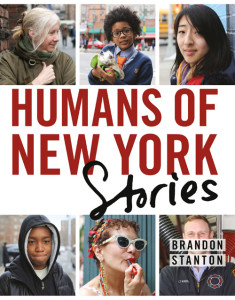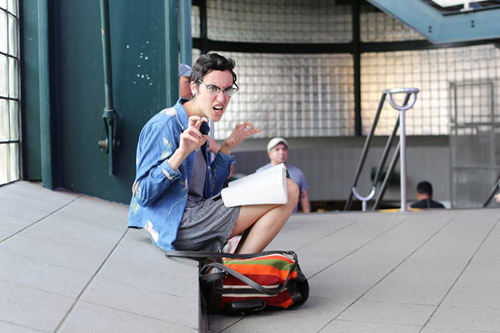Macmillan Australia
October 2015
 If there’s one thing that Humans of New York: Stories makes clear, it’s that everyone is the hero of his or her own story. And while, yes, this is something that each of us knows, on an intellectual level, applies to every one of us, it can nevertheless cause a quiet unraveling in the confidence of self to read snippets of people’s stories, their everyman journey, and witness the illusion of gravitational pull they perceive of their own life. Because, once you see it, laid out on the page, you then become increasingly aware of the illusion that exists within your own perception, and gravity begins to loosen, and you begin to drift.
If there’s one thing that Humans of New York: Stories makes clear, it’s that everyone is the hero of his or her own story. And while, yes, this is something that each of us knows, on an intellectual level, applies to every one of us, it can nevertheless cause a quiet unraveling in the confidence of self to read snippets of people’s stories, their everyman journey, and witness the illusion of gravitational pull they perceive of their own life. Because, once you see it, laid out on the page, you then become increasingly aware of the illusion that exists within your own perception, and gravity begins to loosen, and you begin to drift.
To go one step further, Humans of New York: Stories is, perhaps unintentionally, a fascinating glimpse into the construction of self that we all experience throughout our life. Our personalities, and by extension, our sense of self, is not simply the sum total of our past experiences, but is in fact shaped by memories, aspirations and social conditioning. It’s this last one that we perhaps find the most difficult to accept because it suggests that we (in our individualistic culture) are not quite as independent as we’d like to think we are. Each of us is not a special snowflake of individuality, but rather a socially constructed version of acceptable social norms. It’s only when we see the patterns of social behaviour repeated, in print, in front of us, that the mirage begins to shatter.
For the uninitiated, Humans of New York (HONY) is the online photography project of Brandon Stanton. Stanton roves the streets of New York, collecting, like an urban ethnologist, the stories of the people he encounters on the streets, and stamps these stories with a photo as if to capture an elusive butterfly; sometimes brown and subdued to blend into the background of the city, and other times brightly coloured and vibrant, a visual demand to be seen.
In the early days of the project, the photos were entirely the point, with Stanton first posting photos without words as a silent portrait. Looking back, the voicelessness of the early participants is almost unbearable. Each person is a cut out waiting to be inflated with the fullness of story. Gradually, as the project progressed, a handful of words were added to photos, a sentence of insight or words of confession. Then, slowly, these sentences became a paragraph, and a paragraph become several. It’s these more recent stories that populate the pages of Humans of New York: Stories like a scientific catalogue where people let us glimpse through the window of their privacy, which, in the normal course of things, would be otherwise unobtainable.
It’s when these stories are collected together, in this chronicle of small lives in New York City, that we see the commonality between people. Not just the commonalities that Stanton would perhaps like us to see, such as the universal struggles for meaningfulness and a good life that ignore race, gender and economic status. But what we also get to see are the socially constructed trends that drive personality. Would you expect to see a difference in response between (white) men and women when faced with a failure to succeed? A read of HONY suggests that men are more likely to identify as misunderstood geniuses, while women have a tendency to self-blame. And that’s just the beginning. What a marvellous tool we might have in HONY: Stories to be able to examine the subtleties of language as it reflects social conditioning and identity. Can we identify the tropes of our own stories?
Of course, the template of stories that we see is part of the reason that Humans of New York: Stories resonates as much as it does. While we might start to feel a bit of a wobble in our own Hero’s Journey, we are stabilised by the sense of togetherness we get to share with people we have never met, but who we nevertheless feel we understand. Stories connect us. They tell us we are not alone, and that battles can be won. And we also get to remember that there’s a cool dinosaur face in all of us.
“Should I do my dinosaur face?”
“Yes.”


